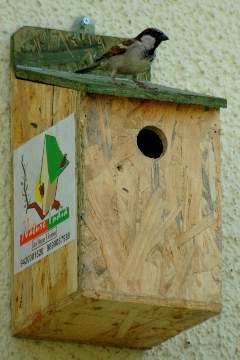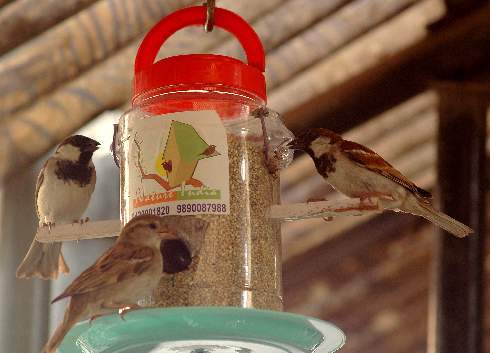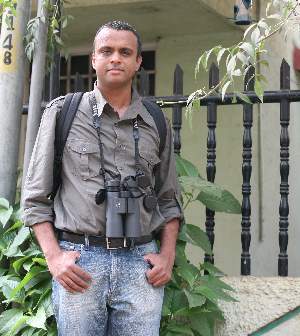There is something wrong with a city that remains unperturbed even as its birds desert it. And that seems to be true with most metros in India where house sparrows have almost become a thing of the past.
The Indian city has high-rises, flashy glass-and-chrome structures, and also passionate citizens all out to save heritage buildings and shrinking lung spaces. It also has endless streets of tenements, tumble-down shacks, and antithetical slums abutting on skyscrapers. Between these incongruities lurk disconnect, disenchantment, and despair all merging into one landscape called urban.
Much as we try to defend the seemingly irreversible modern life, we cant stop our hearts from crying when we realise that our rapidly degenerating urban eco-system isnt generous enough to let the delicate winged creatures build tiny little nests in its nooks and crannies, sit in solitude, and rear offspring.

![]() A specially designed nest box is already playing host to a sparrow.
A specially designed nest box is already playing host to a sparrow.
Thankfully, the situation is not as hopeless as it seems. A small wooden nest box is all it has taken to rekindle all the romance of bringing sparrows and other birds back into our cities and halt them from fading into the past like a forgotten folktale.
The nest box is a heartfelt, self-funded initiative of Nasik-based young man Mohammed Esmail Dilawar, 30, who refused to wallow in the collective hopelessness of the urban ecosystem grappling with its receding tree cover, dwindling birds and insects. Vehicular pollution, overuse of pesticides, criss-crossing electric wires and EMR menace emanating from cellphone towers, and haphazard construction activity spawned by insensitive architecture did not stop this former lecturer in environmental sciences from innovating. Instead of brooding over the problems, it makes sense to look for solutions, he says.
It is this positive approach that prodded him quietly into painstaking research on birds nesting habits and design boxes for sparrows and other cavity-nesting birds like maina, owls, robins and other garden birds, and even rose-ringed parakeets. The objective is to help people get involved directly in conservation by putting up a nest box in their balconies or windows and feed them on a regular basis through a feeder. By doing so, they are creating a safe habitat for sparrows.
Made of 100-percent recycled wood and eco-friendly paint, each of the 10 boxes priced at Rs 250-2,500 is meticulously designed keeping in mind the height and width of the box, the size of the hole, and space needed for hatching. If hung outdoors, a bird feeder (Rs 75) attracts a variety of birds.
It is designed in such a way that parakeets cannot enter a box designed for sparrows. It is neither too small that the little ones get cramped, nor too big that the birds have to bring in extra nesting material, says Dilawar, who received Time magazines Heroes of the Environment award in 2008 for his fight to keep the environment cleaner and greener.
Dilawars efforts began five years ago when he read a study on declining number of sparrows in Britain. It didnt take long to realise that the situation in India was no better. However, barring a report by the Indian Council of Agricultural Research on the dramatic fall in the number of sparrows in southern India, Dilawar did not have any other scientific research to rely on. Then, there was absolutely no awareness on this issue. The concept of sparrow conservation was in its infancy and it is so even now. Its also because of our socio-economic conditions; our deepest concerns are still too fundamental like food, clothes and shelter, he says.

Sparrows are drawing their share of grains from a bird feeder, which can be used with the nest box.
Regretting the criminal lack of concern for biodiversity like small mammals, common birds, and insects found in metros, Dilawar feels that we must put in place a national consensus on the issue, conservation measures, and clear-cut government policies to ensure that urban architecture allocates space for birds to build nests. If sparrows are disappearing, its a grim reminder of the degrading environment we are living in.
He gave up his lecturers post at a college and followed his passion of saving sparrows. Prior to this, Dilawar rejected an offer to work for tiger conservation which, he thinks, grabs all the limelight. In fact, he feels saving tigers is relatively easier because you can simply mark off the whole tiger habitat or national parks. People living around the reserved areas become stakeholders. But to save a species like house sparrow which lives among human beings, emotional attachment to the bird is essential. Awareness on planting native trees, herbs and shrubs, and doing away with pesticides in gardens is necessary to create a safe and sustainable living environment for birds and other species. But our modern life alienates us from this association that our ancestors nurtured for thousands of years.
At least, for Mumbai-based Dipti Vaishnav, an Accenture employee, alienation from nature isnt an issue so long as she sees the sparrow couple flutter around her flat. Even amidst the breathless tumult of Mumbai city, the nest box she bought three years ago was occupied just a couple of weeks after she hung it on her bedroom window.
Made of 100-percent recycled wood and eco-friendly paint
Priced at Rs 250-2,500
Meticulously designed
If hung outdoors, a bird feeder (Rs 75) attracts a variety of birds.
![]() A sparrow couple began residing in the nest and it has never been vacant since. It is such a beautiful experience to see this sparrow couple hatch new ones and teach them fly. Babies keep growing and fly out of their nest constantly. Her family her husband, kid, and in-laws are so attuned to the chirrupy sparrows that they bought another nest recently. We never interfere with the birds. We dont even have to put a bowl of water.
A sparrow couple began residing in the nest and it has never been vacant since. It is such a beautiful experience to see this sparrow couple hatch new ones and teach them fly. Babies keep growing and fly out of their nest constantly. Her family her husband, kid, and in-laws are so attuned to the chirrupy sparrows that they bought another nest recently. We never interfere with the birds. We dont even have to put a bowl of water.
Similarly, Pune-based Rajeev Goel, former employee of Kinetic Hyundai Elevator, hung a nest box on his balcony ceiling and it got occupied almost immediately. A feeder box placed a little away from the nest draws not just sparrows, but also mainas, bulbuls, pigeons, and even nightingales. The fairly green cover around his apartment complex has made the matters easier. Mohammed has done a good job with the designing aspects and its an excellent initiative. This activity is a stress-buster. Once you put up the nest box and the feeder, your job is done. The birds take care of themselves.
Talking of emotional attachment, Hyderabad-based Ramadevi, freelance journalist, speaks endlessly about her chirrupy neighbours. Apart from two natural sparrow nests, she has a nest box and a feeder put up in her balcony years ago. She puts a bowl of water, and in fact, in the hot summers of Hyderabad, a big trough for even mainas and parakeets to take a dip into. She ensures water even when she is out of town. Whenever the sparrows hatch, she puts cooked rice in the nest which is easy to digest for the little ones.
The attachment is mutual. On weekends, the birds perch on her bedroom windowsill and get chirpy. I cant sleep late even on weekends, says she. Each time she walks into the balcony, the sparrows get all perked up and expect her to feed them. Not that sparrows are dependent creatures; but when they feed the rice to their babies, its an overwhelming experience. You feel you have done something for the nature.

![]() Mohammed Dilawar.
Mohammed Dilawar.
In Bangalore, Bruhat Bengaluru Mahanagara Palike (BBMP) Forest Cell introduced the concept a few weeks ago and the response has been tremendous. Says Karthik, BBMP Forest Cell volunteer: We have sold thousands of boxes in Bangalore in just one month.
N Maanay, Secretary and Trustee of BNM Institute of Technology, Bangalore, is confident of bringing a whole lot of variety of birds to the campus where he has put up 17-18 nest boxes. A few of them are already playing host to the winged residents. Maanay is sure that all the boxes will be occupied very soon.
Involving people into the save sparrow movement has brought real joy and satisfaction to Dilawar. He says he gets calls, emails from all kinds of nest box adopters like professionals, housewives, children, and elderly people sharing interesting nuggets from their experiences. His plans of taking this campaign to schools are hindered by cash concerns. The idea has caught up very well and we have adopters in every corner of India. The love and affection we get from people is overwhelming at times. We even celebrated March 20 as World House Sparrow Day, he adds.
Currently heading a project on house sparrows in Bombay Natural History Society and furthering the cause through Nature Forever Society, Mohammed is also busy with his ambitious nationwide survey of sparrow population. Recently, his three-member team got approval from an international conservation partner.
Programming will start in a couple of months. We have absolutely no data on sparrow distribution patterns or the degree of their extinction. Barring Dr Salim Alis work 60 years ago, we are not aware whether they have been able to establish new habitats in places where they were absent earlier. This system will help us get that baseline data. It will be rough but indicative.
The evolution of this survey is rooted in Dilawars outright rejection of saving only endangered species including tigers. For him, selective scientific research and conservation doesnt make sense. We should not distinguish between various categories of species but give equal importance to all species, common or exotic. Sparrows are to urban ecosystems what tigers are to forest ecosystems, he asserts.
To become a nest box adopter, visit www.natureforever.org.
























